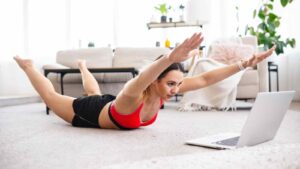A fit body, a healthy mind, and relief from stiffness is what our client Preeti experienced joining us for her health journey. Consistency and dedication go a long way, and our client, Preeti Sachdeva, proves that with her amazing Yoga Asanas transformation.
The team at FlexifyMe helped her add a holistic lifestyle to her routine. And while you may think it’s difficult to be consistent while balancing Yoga practices with a busy life, the results are in front of you.
Let’s take you through her 4 months journey through some of the Asanas guided through by our Trainers.
Uttanasana (Standing Forward Fold)
According to Yogapedia, Uttanasana (Standing Forward Fold) is a standing forward fold, which is considered very good for relieving stress and soothing the nervous system. It forms part of the Surya Namaskar sequences.

Its name comes from the Sanskrit uttana, which means “intense stretch” and asana, which means “a seat” or “posture.”
The Western name for uttanasana is Standing Forward Fold.
Look at how Preeti has aced the Asana in just 4 months period

Uttanasana (Standing Forward Fold) is considered an important posture because, in addition to the physical stretching and strengthening benefits, it is believed to be balancing for the body. This is due to the combined elements of activity and passivity in the body once it is folded into the pose. Like all forward bends, uttanasana (Standing Forward Fold) is believed to be calming for the mind. It is a posture of surrender and, as such, may teach one patience and acceptance. Furthermore, the increased blood flow to the brain and the inverted nature of the posture, with the heart above the head, is said to relieve stress.
Badhakonasana
Baddha konasana (Bound Angle Pose) is a basic seated asana that opens the hips and the muscles of the groin. The term comes from the Sanskrit baddha, meaning “bound,” kona, meaning “angle” and asana, meaning “pose” or “posture.” by Yogapedia

To enter the pose, sit with the back straight, directly on the sit bones of the buttocks. Bend the knees, bringing the feet together in front of the body with the toes, arches and heels pressed against each other while the hands remain on the feet. Keeping the feet together, bring the heels as close to the groin area as comfortable. Enjoy deep breaths in this pose for as long as needed. Individuals can also practice the pose by gently bouncing the legs up and down like butterfly wings, or by tilting the upper body forward at the hips, keeping a straight spine, to increase the stretch.
Preeti shows how she has managed to bring this pose to life

Bhujangasana
Bhujangasana is the Sanskrit name for a popular yoga asana, otherwise known as Cobra Pose (aka Bhujangasana). It is a gentle backbend, most commonly performed as part of a Sun Salutation, in which it can be used as a less strenuous alternative to Urdhva Mukha Svanasana (Upward Facing Dog). The term is derived from two Sanskrit roots; bhujanga, meaning “serpent” or “snake” and asana meaning “seat” or “posture”. by Wikipedia

To enter the pose:
- First lie prone on the floor with the legs outstretched and feet hip-width distance apart.
- Place the palms down directly below the shoulders, with elbows bent and hugged in towards the torso.
- Pressing the tops of the feet and the pubic bone firmly into the floor, inhale to lift the chest and begin to straighten the arms.
- Keep the shoulders away from the ears, and draw the shoulder blades towards one another to maintain an open chest.
- Only lift as far as possible whilst still keeping the pubic bone connected to the mat, and hold this position for as long as the breath can remain smooth and steady.
- The gaze should be fixed at one point on the floor, in order to maintain a neutral neck position.
- To come out of the pose, exhale to slowly lower back down towards the floor.
- If this pose causes any strain in the lower back, the elbows can remain bent in a modification known as Baby Cobra.
- Alternatively, the forearms may remain on the mat with palms facing down for salamba bhujangasana (Sphinx Pose), a gentler version which may be used to work towards bhujangasana. In order to find a deeper expression of the pose, the hands can be walked closer towards the torso with the arms straight, providing a stronger backbend.

Bhujangasana should not be practiced by those with carpal tunnel syndrome or any injury to the back, arms, or shoulders. Additionally, it should be avoided in the case of recent abdominal surgery or pregnancy.
Checkout other Yoga Asanas / Poses such as Mountain Pose Yoga Steps written by our experts and grab it’s benefits.
Frequently Asked Questions
What benefits does meditation offer for managing stress and improving sleep?
FlexifyMe's meditation sessions are crafted to aid in stress relief and enhance sleep quality, forming an integral part of our comprehensive wellness programs.
Can FlexifyMe help with weight loss through yoga?
Yes, our programs include yoga for weight loss, combining physical postures, breathing techniques, and meditation to help you achieve your fitness goals in a holistic manner.
Are FlexifyMe's yoga and meditation programs suitable for beginners?
Absolutely, we offer yoga for beginners and meditation guidance that's customized to your pace and starting level, ensuring a supportive and effective introduction to wellness.
How do FlexifyMe's corporate wellness programs benefit employees?
Our corporate wellness programs are designed to promote health and fitness in the workplace, offering online yoga classes and meditation sessions that fit into busy schedules and support overall employee well-being.
What kind of personalized yoga instruction does FlexifyMe provide?
Our personalized yoga instruction is tailored to individual health and wellness goals, ensuring you receive one-on-one guidance that caters to your specific needs, whether it's for fitness, stress relief, or prenatal care.
How does FlexifyMe accommodate prenatal yoga needs?
We offer specialized prenatal yoga sessions that focus on gentle poses and breathing techniques to support health and wellness throughout pregnancy.
What differentiates FlexifyMe's approach to wellness and fitness?
FlexifyMe's holistic approach combines yoga, meditation, and nutrition advice, offering a rounded path to health and fitness that adapts to your lifestyle and personal goals.
Can FlexifyMe's online yoga classes be scheduled around my busy lifestyle?
Yes, our online yoga classes offer flexible scheduling options to seamlessly integrate into your lifestyle, ensuring you can maintain your fitness and wellness routine without hassle.
Does FlexifyMe offer any specialized programs for stress relief?
Our wellness programs include specialized yoga and meditation sessions focused on stress relief, designed to help you manage anxiety and improve your overall health.


